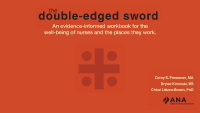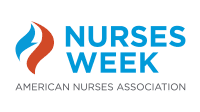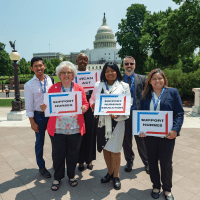National Commission finds nurses of color harmed by practices, policies, individual behaviors across key aspects of the profession
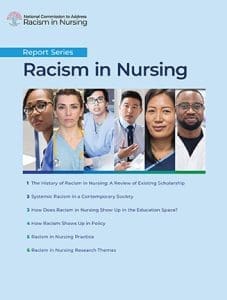 In a major series of 6 reports issued in May, the National Commission to Address Racism in Nursing (the Commission) found racism thoroughly embedded in four key aspects of the profession—education, practice, research, and policy—as part of contemporary society, and throughout its history (View the full report here).
In a major series of 6 reports issued in May, the National Commission to Address Racism in Nursing (the Commission) found racism thoroughly embedded in four key aspects of the profession—education, practice, research, and policy—as part of contemporary society, and throughout its history (View the full report here).
Release of these reports signifies important recognition by the nursing profession of racism in its ranks—and a path forward, according to ANA Enterprise CEO Loressa Cole, DNP, MBA, RN, NEA-BC, FAAN. “Racism in nursing is certainly not a new problem, but it’s one that hasn’t been acknowledged as it should’ve been. That’s the first step,” she said. “It really gets back to the nursing process that guides all nurses. We’ve assessed the situation. We know there’s a problem, and now we must execute on interventions to address it.”
Stark assessment
The release of these reports lays out in sometimes stark terms the state of racism in nursing. “Nurse perpetrators as well as enablers of racism undermine the respect and human dignity of … nurses [of color] who strive to provide safe, effective care to their patients,” according to the report on racism in nursing practice.
Historically, “scientific racism in nursing curricula and textbooks, prepared a nursing workforce to deliver discriminatory care, reinforcing the status quo of medical apartheid in America,” noted the report on the history of racism in nursing. In the modern era, “it is common to see stereotypes being taught through patient-provider scenarios, case studies, simulation, and in the clinical setting. Nursing textbooks are commonly written without references to or input from highly skilled scholars from minoritized groups.” This omission serves to “perpetuate stereotypes and nonscientific, biased beliefs,” according to the report.
The report on systemic racism in contemporary society notes that “a plethora of literature supports that the remnants of racism continue to smolder in and around the discipline of nursing.”
A body of work
This series of reports marks a crescendo of output by the Commission, founded in January 2021 by ANA along with 20 partnering organizations and three co-leading associations, including the National Black Nurses Association (NBNA), National Coalition of Ethnic Minority Nurse Associations (NCEMNA), and National Association of Hispanic Nurses (NAHN). The Commission was formed in the wake of the murder of George Floyd in May 2020, at the knee of a Minneapolis police officer. At its June 2020 meeting the ANA Membership Assembly condemned Floyd’s death and pledged to, “In partnership with nurses everywhere educate, advocate, and collaborate to end systemic racism, particularly within nursing.”

The inclusive makeup of the Commission is a step toward fulfilling this pledge, according to Commission co-lead and ANA President Ernest J. Grant, PhD, RN, FAAN. “We had all the major nursing organizations and the four co-lead organizations coming together along with nursing organizations that represent nurses of color,” he observed. “We had at the table subject matter experts, thought leaders, and people who help to make policies. And we deliberately asked and kept asking who else needed to be there to keep this agenda moving forward.”
Early in 2021 the Commission hosted listening sessions to hear directly from nurses of color about the impact of racism on their professional practice and advancement within the profession. The Commission also surveyed more than 5,600 nurses, finding that nearly two-thirds (63%) reported having personally experienced an act of racism in the workplace (nursingworld.org/survey-on-racism). In November 2021, the Commission released a new definition of racism (See Box).
Box
National Commission to Address Racism in Nursing
Co-lead organizations
American Nurses Association
National Association of Hispanic Nurses
National Black Nurses Association
National Coalition of Ethnic Minority Nurse Associations
Member organizations
American Academy of Nursing
American Association for Men in Nursing
American Association of Colleges of Nursing
American Nurses Credentialing Center
American Nurses Foundation
American Organization of Nursing Leadership
ANA Eastern Region of Constituent and State Nurses Associations
ANA Midwestern Region of Constituent and State Nurses Associations
ANA South Eastern Region of Constituent and State Nurses Associations
ANA Western Region of Constituent and State Nurses Associations
Asian American/Pacific Islander Nurses Association
Chi Eta Phi
Minority Fellowship Program at the American Nurses Association
National Alaska/Native American Indian Nurses Association
National Association of Indian Nurses of America
National Association of Licensed Practical Nurses
National League for Nursing
Organization for Associate Degree Nursing
Philippine Nurses Association of America
The Minority Nurse
A draft copy of the reports released in January garnered 160 sets of public comments. In all, 86 participants contributed to the series of 6 reports.
2022 benchmark

The Commission views the series of reports as foundational to the profession’s understanding of racism in 2022 and as a spur to institutions, nursing associations, and individual nurses to acknowledge and act to dismantle racism, according to Commission Co-lead Adrianna Nava, PhD, MPA, MSN, RN, president of NAHN. “The report should be a catalyst for nurse leaders at healthcare institutions and professional organizations to ask themselves how they can make a difference for their nursing community. Racism is a public health issue within our society, and this is an opportunity for us to develop best practices for addressing racism that can be modeled in other settings,” she said. “It’s important for us as a profession to learn to discuss difficult and sometimes challenging topics such as this and set the example for the rest of the country.”
Racism, the report series found, has been present in nursing throughout its history—from its origin story through the push in the 1970s by nurses of color to create associations such as NBNA and NAHN that better reflected their needs, interests, and desire to contribute to the profession’s development. While major turning points are clear in the historical record, nuances and deeper insights about injustices are less apparent, owing to a “dearth of disciplinary scholars” who, by asking a different set of questions, might “repair the vast holes” in the historical literature when it comes to confronting the roots of racism in nursing.
The Four “I”s
The series of reports identifies the Four “I”s of oppression—ideological, institutional, interpersonal, and internalized—as a framework for considering how racism historically has and continues to manifest in nursing. The document calls out overt ways racism affects nurses of color, such as being misidentified as patient transporters, being told as nursing leaders they won’t last long in their positions, and experiencing assignment changes at the request of patients or family members.
Institutionalized racism appears in long-standing practices and policies that perpetuate harms. For instance, hair policies can be based on “dehumanizing beliefs” that associate hairstyles with uncleanliness or unprofessionalism.

For many nurses of color—including Commission members themselves—these findings reflect their own life journeys. “When you’re a nurse of color and you experience these things, sometimes you start to wonder if you’re making it up in your head or if it’s actually happening. This report validates those experiences,” said Commission Co-lead and at-large member Daniela Vargas, MSN, MPH, MA, RN, PHN. Confronted with micro-and macroaggressions as well as systemic policies and practices rooted in racism, nurses of color report being demoralized, insecure, self-doubting, and of having feelings of sadness, isolation, and of being “less human,” according to the report. “By its very nature,” the report on racism in nursing practice emphasizes, “racism is antithetical to the ethical ideals of the profession in its inherent perpetuation of disrespect, unfairness, and harm.”

These findings and others throughout the report series underscore the exigency for change within the profession, according to Commission Co-lead Martha A. Dawson, DNP, RN, FACHE, president and CEO of NBNA. “For too long, our profession has treated racism as a small, localized abnormality when it is an open wound. Nurses know that a sterile bandage will not remove infection,” she said. “Nursing has the opportunity to look in, lean in, and change our profession. It is not enough to be the most trusted; we must become true healers and heal ourselves.”
Dawson added that “elevating every nurse equally and appreciating the uniqueness of each nurse is the way forward for our profession. We cannot address and help society until we help ourselves and our colleagues.”
A preventable harm
Racism in nursing practice, the report adds, is a disruptive behavior and preventable harm that should be addressed “with the same fervency devoted to other preventable harms that have been prioritized for decades.”
Calling out the systemic nature of racism provides a means to redefine the nursing profession in a more diverse, equitable, and inclusive way, said Vargas.
“When we say that it’s a systemic issue, institutional, and not just the individual, then we’ve changed the conversation. Because now we have to say, why are we allowing these structures and systems to continue to thrive in 2022?,” she observed. “That’s why the work of the Commission is so critical, because nursing has to move in a different direction.”
Challenges in education, policy
Structural and institutional policies and inequities embedded in nursing schools and programs “have the most profound impact on the profession” because of the deep-seeded and long-lived consequences they have on the future of students who progress and who fail, on the nursing workforce, future nurse educators, and on the nation’s health and well-being.
For example, policies that favored baccalaureate degree-prepared nurses for entry into practice didn’t consider the impact this paradigm would have on nurses of color who were more likely to attend community colleges and less likely to be fully accepted in university-based education.
The report on how racism shows up in education calls for leaders who are committed to “real change” and “ready to view their systems from the edge of chaos, not just to innovate, but to eliminate.” The document urges academic leaders to “move beyond hiring [diversity, equity, and inclusion] officers and seek to include equality.”
The report on policy describes three themes that reflect the interplay between policies and racism. First, the systemic and structural nature of policy perpetuates racism. How policies are applied and implemented through explicit or unwritten rules can aggravate the racist impact of any policy. Finally, policies typically reflect the voices in the room when a policy is being developed. Lack of diversity or only token representation by nurses of color preserves a singular point of view—that of the dominant culture.
A safe space, a step forward
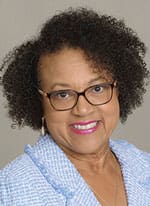
If the series of reports paints a solemn portrait of the profession in 2022, it also lays the groundwork for a dynamic revitalization of nursing, according to Commission Co-lead Debra A. Toney, PhD, RN, FAAN, president of NCEMNA. “Bringing this into the public arena gives people background to understand and an opportunity and a safe space to ask questions and have open communication,” she said. “People hopefully will learn from it, where they can change their behavior and we can all move forward.”
Nursing leaders and healthcare organizations taking the report to heart and developing, implementing, and monitoring the effectiveness of more enlightened policies and procedures will bring one level of change. However, Cheryl Peterson, MSN, RN, vice president of nursing programs at ANA, emphasized that individual nurses also factor greatly in making the profession anti-racist. “The report is a call to action to every nurse and every nursing leader that we are obligated and accountable to address this problem,” she observed. “But we also have work to do on ourselves—the hard work of who we are as individuals, nurses, and as a profession.”
The report series, at more than 120 pages, is not the last stop on the Commission’s journey. Recommendations for positively changing practices and policies will be developed in the coming months.
ANA is among those organizations inspired by the series of reports to assess their past and present policies and actions to create a more diverse, equitable, and inclusive profession in the future.
At its June 2022 meeting, the ANA Membership Assembly took historic action to begin a journey of racial reckoning by unanimously voting yes to adopt a racial reckoning statement from ANA.
Cole emphasized that this work, challenging though it may be, offers big rewards for the profession—and the nation’s health. “If nurses can become ambassadors for addressing this societal, systemic issue, then our profession and our patients will be better served.”
—Genna Rollins is writer-editor at ANA.





